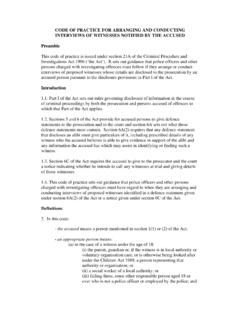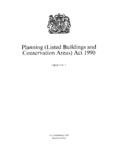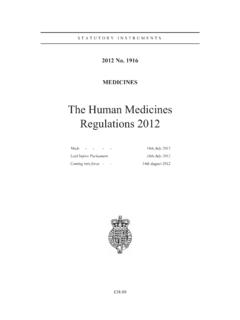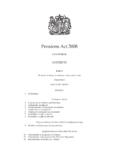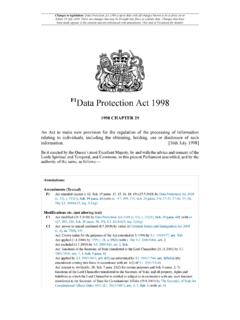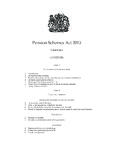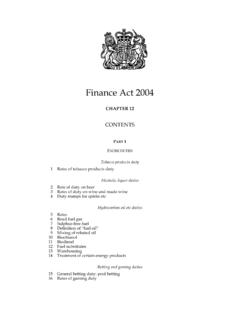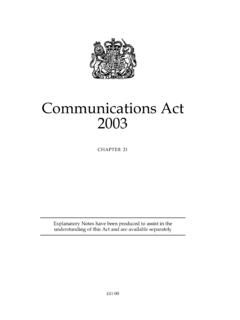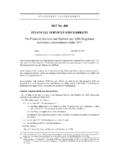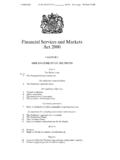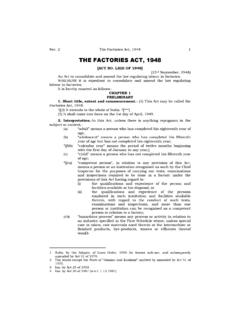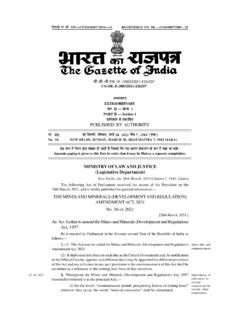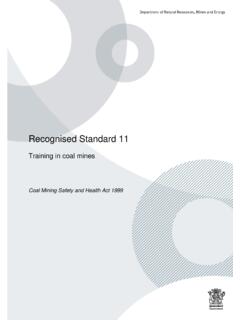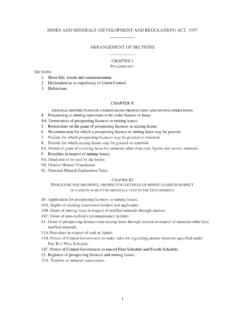Transcription of The Electricity at Work Regulations 1989 - Legislation.gov.uk
1 Status: This is the original version (as it was originally made). This item of legislation is currently only available in its original format. STATUTORY INSTRUMENTS. 1989 No. 635. HEALTH AND SAFETY. The Electricity at Work Regulations 1989. Made - - - - 7th April 1989. Laid before Parliament 25th April 1989. Coming into force - - 1st April 1990. The Secretary of State, in exercise of the powers conferred on him by sections 15(1), (2), (3)(a) and (b), (4)(a), (5)(b), (6)(b), (8) and (9) and 82(3)(a) of, and paragraphs 1(1)(a) and (c), (2) and (3), 6(2), 9, 11, 12, 14, 15(1), 16 and 21(b) of Schedule 3 to, the Health and Safety at Work etc. Act 1974(1). ( the 1974 Act ), and of all other powers enabling him in that behalf and for the purpose of giving effect without modifications to proposals submitted to him by the Health and Safety Commission under section 11(2)(d) of the 1974 Act, after the carrying out by the said Commission of consultations in accordance with section 50(3) of that Act, hereby makes the following Regulations : PART I.
2 INTRODUCTION. Citation and commencement 1. These Regulations may be cited as the Electricity at Work Regulations 1989 and shall come into force on 1st April 1990. Interpretation 2. (1) In these Regulations , unless the context otherwise requires . approved means approved in writing for the time being by the Health and Safety Executive for the purposes of these Regulations or conforming with a specification approved in writing by the Health and Safety Executive for the purposes of these Regulations ;. circuit conductor means any conductor in a system which is intended to carry electric current in normal conditions, or to be energised in normal conditions, and includes a combined neutral (1) 1974 c. 37; sections 15 and 50 were amended by the Employment Protection Act 1975 (c. 71), Schedule 15, paragraphs 6.
3 And 16 respectively. Document Generated: 2017-07-16. Status: This is the original version (as it was originally made). This item of legislation is currently only available in its original format. and earth conductor, but does not include a conductor provided solely to perform a protective function by connection to earth or other reference point;. conductor means a conductor of electrical energy;. danger means risk of injury;. electrical equipment includes anything used, intended to be used or installed for use, to generate, provide, transmit, transform, rectify, convert, conduct, distribute, control, store, measure or use electrical energy;. firedamp means any flammable gas or any flammable mixture of gases occurring naturally in a mine;. injury means death or personal injury from electric shock, electric burn, electrical explosion or arcing, or from fire or explosion initiated by electrical energy, where any such death or injury is associated with the generation, provision, transmission, transformation, rectification, conversion, conduction, distribution, control, storage, measurement or use of electrical energy.
4 Safety-lamp mine means . (a) any coal mine; or (b) any other mine in which . (i) there has occurred below ground an ignition of firedamp; or (ii) more than by volume of firedamp is found on any occasion at any place below ground in the mine;. system means an electrical system in which all the electrical equipment is, or may be, electrically connected to a common source of electrical energy, and includes such source and such equipment. (2) Unless the context otherwise requires, any reference in these Regulations to . (a) a numbered regulation or Schedule is a reference to the regulation or Schedule in these Regulations so numbered;. (b) a numbered paragraph is a reference to the paragraph so numbered in the regulation or Schedule in which the reference appears. Persons on whom duties are imposed by these Regulations 3.
5 (1) Except where otherwise expressly provided in these Regulations , it shall be the duty of every . (a) employer and self-employed person to comply with the provisions of these Regulations in so far as they relate to matters which are within his control; and (b) manager of a mine or quarry (within in either case the meaning of section 180 of the mines and Quarries Act 1954(2)) to ensure that all requirements or prohibitions imposed by or under these Regulations are complied with in so far as they relate to the mine or quarry or part of a quarry of which he is the manager and to matters which are within his control. (2) It shall be the duty of every employee while at work . (a) to co-operate with his employer so far as is necessary to enable any duty placed on that employer by the provisions of these Regulations to be complied with; and (b) to comply with the provisions of these Regulations in so far as they relate to matters which are within his control.
6 (2) 1954 c. 70; section 180 was amended by 1974/2013. 2. Document Generated: 2017-07-16. Status: This is the original version (as it was originally made). This item of legislation is currently only available in its original format. PART II. GENERAL. Systems, work activities and protective equipment 4. (1) All systems shall at all times be of such construction as to prevent, so far as is reasonably practicable, danger. (2) As may be necessary to prevent danger, all systems shall be maintained so as to prevent, so far as is reasonably practicable, such danger. (3) Every work activity, including operation, use and maintenance of a system and work near a system, shall be carried out in such a manner as not to give rise, so far as is reasonably practicable, to danger. (4) Any equipment provided under these Regulations for the purpose of protecting persons at work on or near electrical equipment shall be suitable for the use for which it is provided, be maintained in a condition suitable for that use, and be properly used.
7 Strength and capability of electrical equipment 5. No electrical equipment shall be put into use where its strength and capability may be exceeded in such a way as may give rise to danger. Adverse or hazardous environments 6. Electrical equipment which may reasonably foreseeably be exposed to . (a) mechanical damage;. (b) the effects of the weather, natural hazards, temperature or pressure;. (c) the effects of wet, dirty, dusty or corrosive conditions; or (d) any flammable or explosive substance, including dusts, vapours or gases, shall be of such construction or as necessary protected as to prevent, so far as is reasonably practicable, danger arising from such exposure. Insulation, protection and placing of conductors 7. All conductors in a system which may give rise to danger shall either . (a) be suitably covered with insulating material and as necessary protected so as to prevent, so far as is reasonably practicable, danger; or (b) have such precautions taken in respect of them (including, where appropriate, their being suitably placed) as will prevent, so far as is reasonably practicable, danger.
8 Earthing or other suitable precautions 8. Precautions shall be taken, either by earthing or by other suitable means, to prevent danger arising when any conductor (other than a circuit conductor) which may reasonably foreseeably become charged as a result of either the use of a system, or a fault in a system, becomes so charged;. and, for the purposes of ensuring compliance with this regulation, a conductor shall be regarded as earthed when it is connected to the general mass of earth by conductors of sufficient strength and current-carrying capability to discharge electrical energy to earth. 3. Document Generated: 2017-07-16. Status: This is the original version (as it was originally made). This item of legislation is currently only available in its original format. Integrity of referenced conductors 9.
9 If a circuit conductor is connected to earth or to any other reference point, nothing which might reasonably be expected to give rise to danger by breaking the electrical continuity or introducing high impedance shall be placed in that conductor unless suitable precautions are taken to prevent that danger. Connections 10. Where necessary to prevent danger, every joint and connection in a system shall be mechanically and electrically suitable for use. Means for protecting from excess of current 11. Efficient means, suitably located, shall be provided for protecting from excess of current every part of a system as may be necessary to prevent danger. Means for cutting off the supply and for isolation 12. (1) Subject to paragraph (3), where necessary to prevent danger, suitable means (including, where appropriate, methods of identifying circuits) shall be available for.
10 (a) cutting off the supply of electrical energy to any electrical equipment; and (b) the isolation of any electrical equipment. (2) In paragraph (1), isolation means the disconnection and separation of the electrical equipment from every source of electrical energy in such a way that this disconnection and separation is secure. (3) Paragraph (1) shall not apply to electrical equipment which is itself a source of electrical energy but, in such a case as is necessary, precautions shall be taken to prevent, so far as is reasonably practicable, danger. Precautions for work on equipment made dead 13. Adequate precautions shall be taken to prevent electrical equipment, which has been made dead in order to prevent danger while work is carried out on or near that equipment, from becoming electrically charged during that work if danger may thereby arise.
